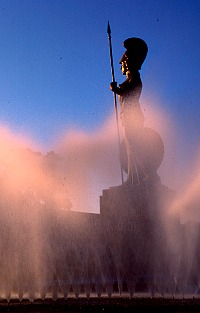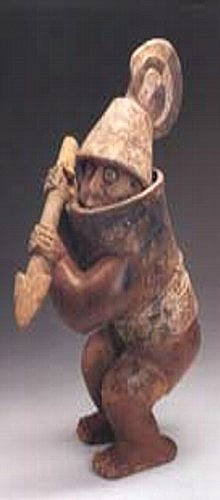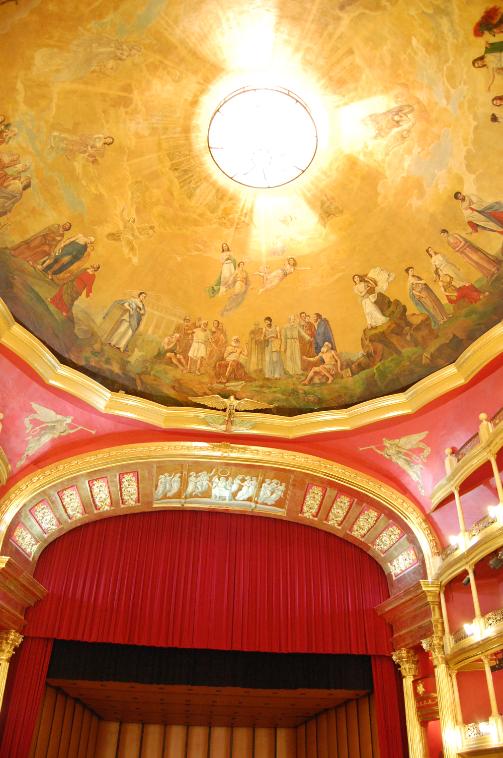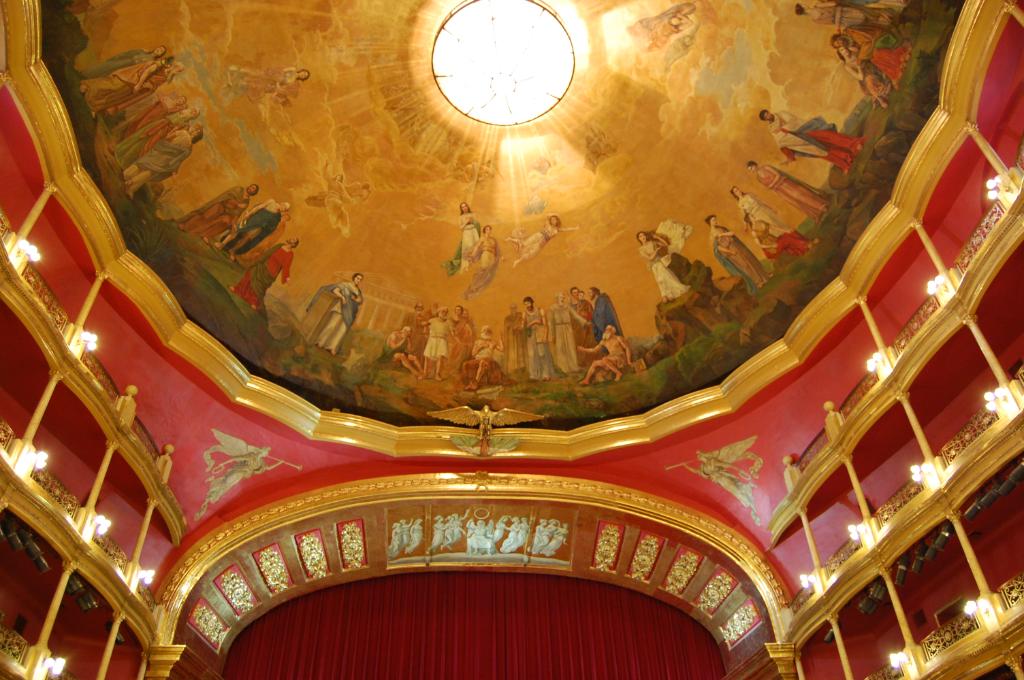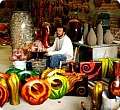
Open for visits between 12:59 - 13:00 hrs only on days when there are no concerts to practice or programed by the local Chamber Of Comerce or the Secretary of Culture or all the important friends of the governor etc ....
At the corner of Morelos St. & Degollado St.
A Neo Classic building constructed by the Architect Jacobo Galvez; on March 5, 1856 the cornerstone was placed. It was finish in 1866 for the Soprano Angela Paralta performance. The portico has 16 architraves Corinth order colums, supporting the tympanum where Apollo and the 9 Muses appear; 1,015 spectators capacity. The vault is decorated with a fresco painting of the IV tune of Dante Aligheri´s Divine Comedy, painted by Jacobo Gálvez and Gerardo Suárez.
Our Most important opera house dates from the year 1866, and was a project designed by the architect Jacobo Gálvez in response to the city´s need of a great theater, ¨worthy of the Jalsican people¨
It was majestically raised in the plaza San Agustin. Originally it was called the Theater de Alarcón, in honer of the great Mexican dramatist, Juan Ruiz de Alarcon, but subsequently upon the death of the projects´s main benefactor, Governor Santos Degollado, it was renamed in his honor
Right from the beginning, construction on the theater was interrupted by the war of Three Years, however dispite the intermittency of the Liberal and Conservative governments, both parties agreed to continue the project and therefore to support the scenic arts as well.
At the corner of Morelos St. & Degollado St.
A Neo Classic building constructed by the Architect Jacobo Galvez; on March 5, 1856 the cornerstone was placed. It was finish in 1866 for the Soprano Angela Paralta performance. The portico has 16 architraves Corinth order colums, supporting the tympanum where Apollo and the 9 Muses appear; 1,015 spectators capacity. The vault is decorated with a fresco painting of the IV tune of Dante Aligheri´s Divine Comedy, painted by Jacobo Gálvez and Gerardo Suárez.
History of
Our Most important opera house dates from the year 1866, and was a project designed by the architect Jacobo Gálvez in response to the city´s need of a great theater, ¨worthy of the Jalsican people¨
It was majestically raised in the plaza San Agustin. Originally it was called the Theater de Alarcón, in honer of the great Mexican dramatist, Juan Ruiz de Alarcon, but subsequently upon the death of the projects´s main benefactor, Governor Santos Degollado, it was renamed in his honor
Right from the beginning, construction on the theater was interrupted by the war of Three Years, however dispite the intermittency of the Liberal and Conservative governments, both parties agreed to continue the project and therefore to support the scenic arts as well.
On September 13, 1866 the Theater de Alarcón was officially inaugurated, although it was still unfinished; ropes held the balconies and walls were left unpainted, The inauguration had been precipitated due to the arrival of Angela Peralta de Castrera, the Mexican songbird, an internationally acclaimed opera singer.
The program for the night´s performance was the Donzetti opera, Lucia de Lammermoor. In 1966 the centennial celebration of the theater´s opening took place with a concert featuring the famous tenor, Placido Domingo, also singing in Lucia de Lammermor.
The program for the night´s performance was the Donzetti opera, Lucia de Lammermoor. In 1966 the centennial celebration of the theater´s opening took place with a concert featuring the famous tenor, Placido Domingo, also singing in Lucia de Lammermor.
The theater has undergone many renovations and alterations since its conception. In 1877 Fermin Riestra reinitiated construction on the unfinished building, and from 1880 to 1890 the stucco on the concert hall was finished. The mondings were gilded and a bronze eagle was mounted on the uppermost center of the proscenium arch.
In 1893 the tiles were removed from the stage roof and replaced with metal, and in 1909 Roberto Montenegro redecorated the interior of the theater and in 1958 redressed the tympanum on the facade with mosics. In 1933 Francisco Sánchez del Castillo altered the paintings on the dome, although they were later removed in order to dampen their billiant color.
From 1959 to 1966 Juan Gil Preciado handed over the final renovations to the architect Ignacio Diaz Morales, asking him to replace the Venetian mosaics of the facade with sculptures by Benito Castañeda, and to carry out a complete restoration of the building
In 1997 the Secretary of Culture began a project aimed at rescuing and restoring our opera house. One of the outcomes was the creation of a small chamber mich hall which holds 200 people and was inaugurated on may 25th 2001.
Our Guadalajara most important Opera House belongs to the neoclassical style of architecture, with a portico at its entrance formed by eight striated columns, and the attractive tympanum featuring the high relief marble sculptures by Castañeda which portray Apollo and the three muses.
On the inside of this magnificent building we find the mural on the central dome which was painted by Jacobo Galvéz with the help of his assistant, Gerardo Suárez. It is called ¨El limbo¨ and represents the Fourth Song of Dante´s Divine Comedy. The stage measures 54 meters by 18 meters. The grand concert hall also features Las Famas, muses posed as if playing music on either side of the stage and a painting of Time and Hours painted by the Jaliscan painter, Felipe Castro that crowns the proscenium arch. A gilded wooden eagle poses on the keystone of the arch, holding the national flag in his talons and a piece of chain in his beak.
In 1893 the tiles were removed from the stage roof and replaced with metal, and in 1909 Roberto Montenegro redecorated the interior of the theater and in 1958 redressed the tympanum on the facade with mosics. In 1933 Francisco Sánchez del Castillo altered the paintings on the dome, although they were later removed in order to dampen their billiant color.
From 1959 to 1966 Juan Gil Preciado handed over the final renovations to the architect Ignacio Diaz Morales, asking him to replace the Venetian mosaics of the facade with sculptures by Benito Castañeda, and to carry out a complete restoration of the building
In 1997 the Secretary of Culture began a project aimed at rescuing and restoring our opera house. One of the outcomes was the creation of a small chamber mich hall which holds 200 people and was inaugurated on may 25th 2001.
Our Guadalajara most important Opera House belongs to the neoclassical style of architecture, with a portico at its entrance formed by eight striated columns, and the attractive tympanum featuring the high relief marble sculptures by Castañeda which portray Apollo and the three muses.
On the inside of this magnificent building we find the mural on the central dome which was painted by Jacobo Galvéz with the help of his assistant, Gerardo Suárez. It is called ¨El limbo¨ and represents the Fourth Song of Dante´s Divine Comedy. The stage measures 54 meters by 18 meters. The grand concert hall also features Las Famas, muses posed as if playing music on either side of the stage and a painting of Time and Hours painted by the Jaliscan painter, Felipe Castro that crowns the proscenium arch. A gilded wooden eagle poses on the keystone of the arch, holding the national flag in his talons and a piece of chain in his beak.
Guadalajara City Tour
Most famous monuments of Guadalajara, discover inside the buildings and plazas
Most famous monuments of Guadalajara, discover inside the buildings and plazas
Guadalajara City Tour
Most famous monuments of Guadalajara, discover inside the buildings and plazas
Most famous monuments of Guadalajara, discover inside the buildings and plazas
Go beyond its
apparent simplicity
apparent simplicity
Call: 33 1578 0421
Guadalajara Map
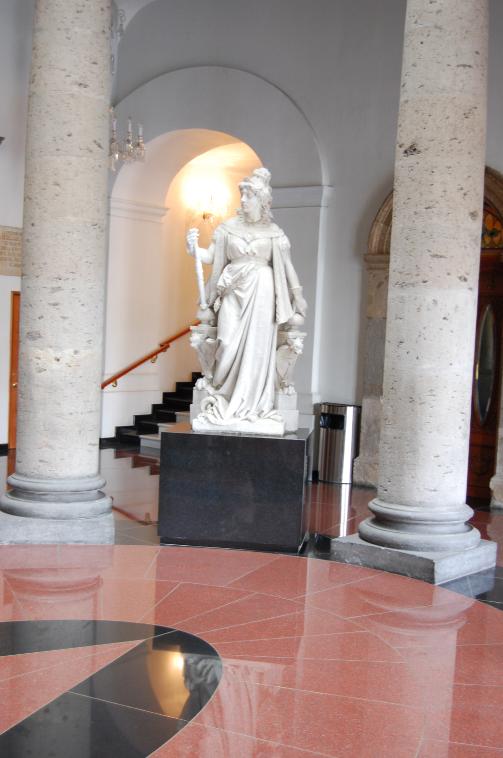
Renovations of Degollado Theater in Guadalajara Mexico
The Degollado Theater belongs to the neoclassical style of architecture
Degollado Theater in Guadalajara Mexico
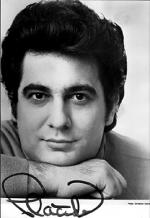
Delivering Value
Through Unique Experiences
Through Unique Experiences


- Hotels in guadalajara
- 5 stars hotels
- 4 stars hotels
- 3 stars hotels
- 2 stars hotels
- 1 star hotels
- Special hotels
